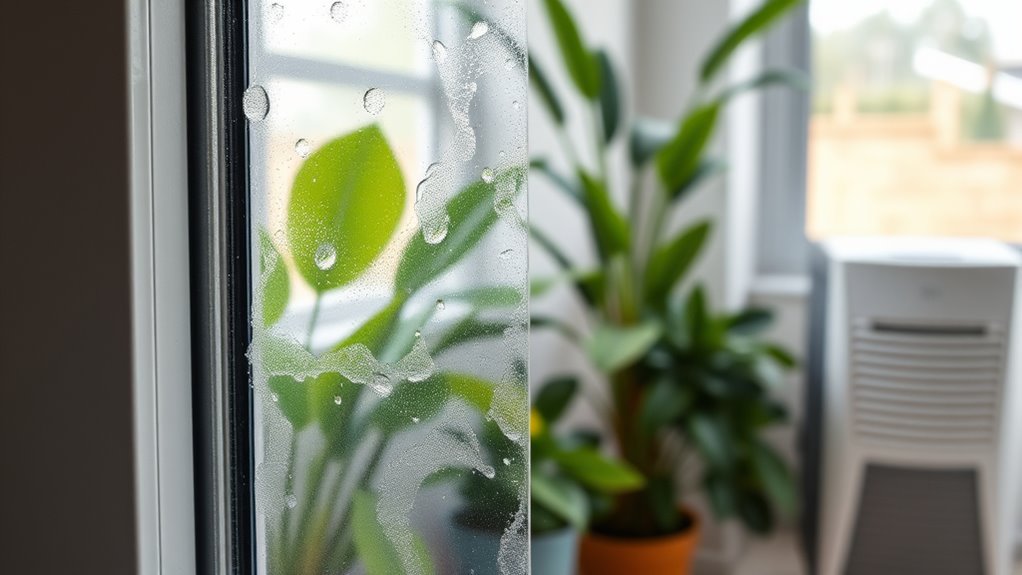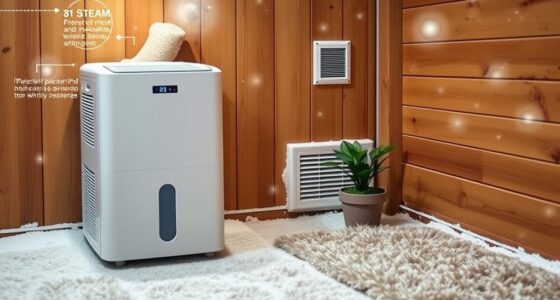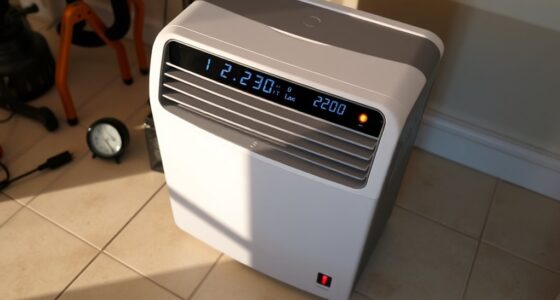To prevent window condensation in humid climates, you should control indoor humidity by using dehumidifiers and ventilating properly. Improve insulation with weatherstripping, double-pane windows, or insulating films to keep glass warmer. Maintaining consistent indoor temperatures helps reduce temperature differences that cause moisture to form. Avoid activities that add excess moisture and ensure good airflow throughout your home. Keep these strategies in mind, and you’ll discover more effective ways to keep your windows clear.
Key Takeaways
- Maintain indoor humidity below 50% using dehumidifiers or ventilation.
- Improve window insulation with weatherstripping, thermal curtains, or insulating films.
- Ensure consistent indoor temperatures to prevent rapid glass cooling.
- Use exhaust fans or open windows during activities that increase moisture.
- Regularly service HVAC systems to optimize humidity control and airflow.

Condensation on windows often occurs when warm, moist air comes into contact with cold glass surfaces, leading to water droplets forming. If you live in a humid climate, this problem can be persistent and frustrating. To combat it effectively, you need to understand the role of HVAC maintenance and window insulation. Proper HVAC maintenance ensures your heating and cooling systems are running efficiently, which helps control indoor humidity levels. When your HVAC system operates correctly, it removes excess moisture from the air, reducing the likelihood of condensation on your windows. Regularly changing filters, checking for leaks, and scheduling professional inspections are key steps to keep your system functioning effectively.
Proper HVAC maintenance reduces indoor humidity, preventing window condensation and keeping your home comfortable.
In addition to HVAC maintenance, improving your window insulation is essential. Windows are often the weakest link in your home’s thermal barrier, especially in humid environments. Installing high-quality window insulations, such as weatherstripping or sealing gaps around the frames, can substantially reduce heat transfer and prevent cold glass from coming into contact with moist indoor air. Double or triple-pane windows with gas fills offer better insulation than single-pane options, keeping interior glass surfaces warmer and less prone to condensation. If replacing windows isn’t an option, consider applying insulating film or thermal curtains, which can help maintain a more consistent indoor temperature and minimize the temperature difference that causes condensation.
Managing indoor humidity levels is also critical. Using a dehumidifier can help keep moisture levels below 50%, which is generally considered safe to prevent condensation. Be mindful of activities that increase humidity, like cooking, showering, or drying clothes indoors, and run exhaust fans or open windows when possible to vent excess moisture outside. Proper ventilation is essential in humid climates, so ensure your home has good airflow to move moist air out and bring in drier air from outside when conditions permit.
Finally, maintaining a steady indoor temperature can make a big difference. Sudden temperature fluctuations cause the glass to cool quickly, increasing condensation chances. Keeping your home heated evenly during colder months helps keep window surfaces warmer, reducing the likelihood of water droplets forming. Additionally, HVAC tuning can optimize system performance to better control indoor climate and humidity levels. Combining regular HVAC maintenance, effective window insulation, humidity control, and steady temperature management creates a thorough approach to preventing window condensation. With these steps, you’ll find it easier to keep your windows clear, your home more comfortable, and your indoor air quality healthier.
Frequently Asked Questions
Can Window Treatments Reduce Condensation?
Window treatments can help reduce condensation by adding insulation and blocking warm, moist air from reaching the cold glass. Using window film creates a barrier that minimizes temperature differences, while venting strategies like opening vents or windows promote airflow, reducing humidity levels indoors. These methods work together to keep your windows drier, preventing condensation buildup and maintaining clearer, more comfortable windows in humid climates.
Do Specific Window Types Resist Condensation Better?
You might wonder if certain window types resist condensation better. Single pane windows tend to fog up more in humid climates because they lack insulation, while double glazed windows help reduce condensation by providing an extra barrier and better thermal regulation. Choosing double glazed windows can be a smart move, as they minimize moisture buildup, keeping your windows clearer and your home more comfortable.
How Does Insulation Impact Window Condensation?
You might think insulation doesn’t affect window condensation, but it actually plays a big role. Thermal barriers created by proper insulation keep indoor air warmer and prevent cold window surfaces. This improves moisture control, reducing the chances of condensation forming. By enhancing insulation around your windows, you create a more stable environment, making it harder for moisture to settle and helping you keep windows clear even in humid climates.
Are Dehumidifiers Effective for Large Windows?
Dehumidifiers can be effective for large windows, especially if you maintain your humidifier properly and use window sealing techniques. Regular humidifier maintenance guarantees it runs efficiently, reducing excess moisture in your space. Proper window sealing prevents warm, moist air from reaching cold surfaces, minimizing condensation buildup. Combining these strategies helps keep your large windows clear and dry, improving comfort and preventing damage caused by excess humidity.
What Are the Long-Term Effects of Condensation?
You might notice condensation leading to interior mold growth and structural damage over time. Persistent moisture encourages mold, which can cause health issues and weaken your walls and window frames. To avoid these long-term effects, you should regularly ventilate your space, control indoor humidity levels, and address any condensation quickly. Doing so helps protect your home’s integrity and keeps your living environment safe and healthy.
Conclusion
By implementing these tips, you’ll find that preventing window condensation becomes easier, almost as if your efforts align perfectly with the natural flow of humidity. Sometimes, it’s as if the right ventilation and insulation choices happen to coincide just when you need them most. When you stay proactive and attentive, you might discover that the persistent moisture clears up almost effortlessly—making your home not only more comfortable but also unexpectedly harmonious with the environment around you.









